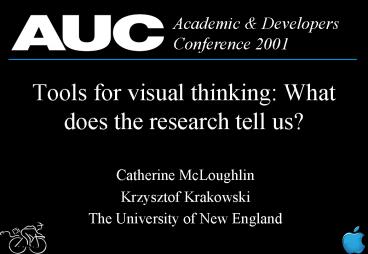Tools for visual thinking: What does the research tell us - PowerPoint PPT Presentation
1 / 24
Title:
Tools for visual thinking: What does the research tell us
Description:
to review the concepts of visual literacy and visual thinking. to suggest a role for the learner in accessing, applying and using ... VL is eclectic in origin ... – PowerPoint PPT presentation
Number of Views:94
Avg rating:3.0/5.0
Title: Tools for visual thinking: What does the research tell us
1
Tools for visual thinking What does the research
tell us?
Academic Developers Conference 2001
- Catherine McLoughlin
- Krzysztof Krakowski
- The University of New England
2
Aim
- to review the concepts of visual literacy and
visual thinking - to suggest a role for the learner in accessing,
applying and using different forms of
representation - to look at ways in which technologies can enhance
cognition, by fostering visual thinking
3
Visual talent and verbal difficulty
- verbally related problems often coexist with
special visual and spatial talent - neurological development - displacement
- Einstein Lewis Carroll Leonardo da Vinci W.B.
Yeats
4
Visual representations
- differ from text-based information
- consist of spatial, non-arbitrary and continuous
images - can represent temporary and causal relations
between states - can capture characteristics of complex events and
concepts
5
visual literacy- visual thinking
- VL is eclectic in origin
- visual competencies- normal human learning
enables discrimination and interpretation of
visible actions, words and symbols
6
Visual literacy
- visual literacy can be defined as a group of
skills which enable an individual to understand
and use visuals for intentionally communicating
with others (Debes, 1972).
7
Several theories
- Howard Gardner (1993) Theory of multiple
intelligencesOnly if we expand and reformulate
our view of what counts as human intellect will
be be able to devise more appropriate ways of
assessing it and more effective ways of educating
it. (p. 4).
8
Multiple intelligences
- linguistic, musical, logical-mathematical,
spatial, bodily-kinaesthetic, personal - spatial (visual intelligence) is a unique form of
intellect, of equal importance to linguistic
intelligence - spatial and visual intelligence are the principal
sources of problem solving
9
World watcher project
- http//www.worldwatcher.nwu.edu/software.htm
10
Chemical visualisation tools
- Understanding chemical bonding
- See complex atomic interactions
- View rotate and measure molecules
- Modify and construct new moleculesCHIME/RASMOL
11
Cognitive pluralism
- critical role of signs and symbols in action and
reflection - thought and cognition are mediated by cognitive
tools - use of multiple cognitive resources facilitates
problem solving
12
Multiple intelligences or cognitive pluralism?
- some common ground thinking does not consist
only of propositions - language is regarded as only one part of the
human representational system - humans play an active role in using and
transforming cultural tools and signs
13
Implications for practice
- all knowledge is constructed all learning is a
process of construction - many world views can be constructed, so there
will be multiple perspectives - knowledge is context dependent
- learning is mediated by tools and signs
- learning is an inherently social
14
visual literacy
- pluralistic theoretical basis of the term
- can mean different things depending on ones
viewpoint - Visual literacy- the ability to both understand
and make visual statements- we become sensitised
to the world around us, the relationships and
systems of which we are a part
15
multimedia technology instructional advantages
- more visual cues colour, icons, animation
- reduces cognitive load so that higher order
processes can be supported - can characterise different aspects of knowledge
and make it more explorable - students can construct mental models
16
Visual literacy operationalised
- VL can be operationalised in terms of visual
learning, thinking and communication - visual thinking manipulation of mental imagery
- visual learning learning from visuals
- visual communication using visual symbols to
convey meaning
17
Visualisation
Learning ?
Thinking?
Communication?
18
Continuum of visual literacy
visual thinking
visual learning
visual communication
manipulating
construction of knowledge
using pictorial and visual
respresenting
forms for transaction and
through interaction
dialogue
with visual phenomena
19
Visualisation in learning
- prestige of non-verbal approaches have eclipsed
earlier methods of learning by apprenticeship - visual-spatial approaches to learning are rare
- conventional education systems are weighted
towards verbal and numerical approaches to
acquiring information
20
New visualisation tools ?
- highly visual learning environments
- greater emphasis on visual representation and
analysis - more emphasis on intuitive, interactive learning
- computers and people working together partners
in cognition - multiple approaches - multiple solutions
21
Impact of technology on visualisation
- how do we visualise information for transmission
to others? - visualisation, because of the computer is
emerging as a distinctive new discipline - capacity of technology to show dynamic, visual
representations and to represent temporal and
causal relationships between states
22
Lets go to UNE...
- http//online.une.edu.au
- http//www.covis.nwu.edu/
23
Supporting visual thinking and learning
- represent concepts in a visible and changing way
- enable the learner to organise, integrate and
interconnect new concepts with previous knowledge - support multiple representational forms such as
graphs, timelines/diagrams - generate new interpretations through semantic
mapping
24
QA

